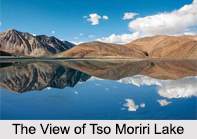 Tso Moriri Lake is famous for the large herds of kiang or wild ass which graze on its shore. The lake of Tso Moriri lies in the less populated region of Rupshu. The lake is at an altitude of 4,522 meters. It is the largest of the high altitude lakes entirely within India and entirely within Ladakh. It is about 16 miles in length and 2 to 3 miles in width. Tso Moriri Lake has no outlet at present and the water is brackish though not very perceptible to taste. The water of Tso Moriri Lake comes from the springs and the melted snow from adjacent mountains. The waters mostly enter the lake in two major streams; one is from north and the other from southwest. Tso Moriri Lake is an endorheic lake. It is oligotrophic in nature, and its waters are alkaline.
Tso Moriri Lake is famous for the large herds of kiang or wild ass which graze on its shore. The lake of Tso Moriri lies in the less populated region of Rupshu. The lake is at an altitude of 4,522 meters. It is the largest of the high altitude lakes entirely within India and entirely within Ladakh. It is about 16 miles in length and 2 to 3 miles in width. Tso Moriri Lake has no outlet at present and the water is brackish though not very perceptible to taste. The water of Tso Moriri Lake comes from the springs and the melted snow from adjacent mountains. The waters mostly enter the lake in two major streams; one is from north and the other from southwest. Tso Moriri Lake is an endorheic lake. It is oligotrophic in nature, and its waters are alkaline.
According to the classifications of the Himalayan Lakes there are four groups and Tso Moriri falls under the third group "remnant lakes". Tso Moriri Lake is 20 to 50 kilometers southeast of the elevated valley of the core Rupshu Valley. It falls within the greater Rupshu Plateau and valley area. The lake is surrounded by hills rising over 6,000 meters. Changpas, the nomadic migratory shepherds of yak, sheep, goat, and horses of Tibetan origin and who are engaged in trade and work on caravans in Ladakh region, are the main inhabitants of the area. Changpa, also called Champa herders use the land of this valley as grazing ground and for cultivation.
Visiting information on Tso Moriri Lake
Tso Moriri Lake is situated to the southeast of Leh in eastern Ladakh of Jammu and Kashmir, at a road distance of 240 km. One can directly reach the Tso Moriri Lake from Pangong Tso via Changtang region. The distance from Pangong Tso to Tso Moriri is 235 km. This is considered to be the most beautiful drive in the Ladakh region.
To save the environment from the tourists some rules and regulations have been laid, that no one can occupy the open space within 700 km of the shoreline. Tourists should bring their own eatables and take their scattered trash away. The open space around Tso Moriri is a pleasant place for trekking experiences.



















